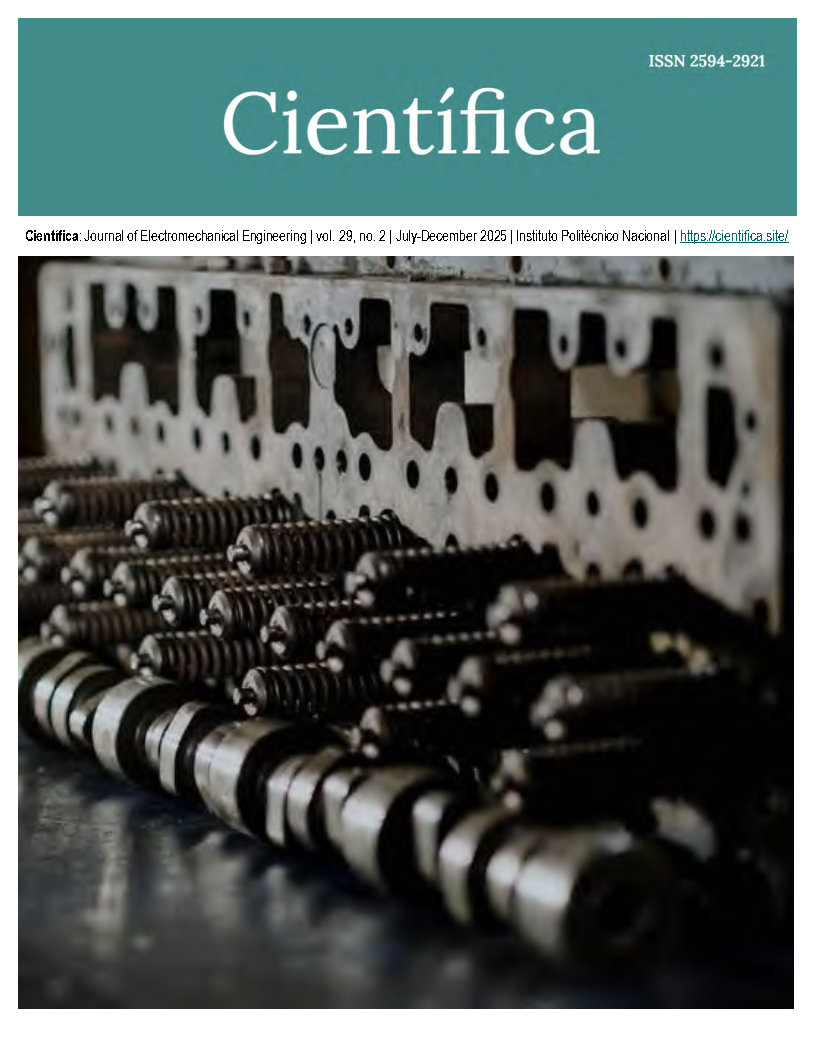Study and Analysis of the of charge and discharge state of lead-acid batteries using moving average filter techniques
DOI:
https://doi.org/10.46842/ipn.cien.v29n2a02Keywords:
filter, voltage, current, battery, charge, discharge, energy, noiseAbstract
The lead-acid batteries have become the most popular energy storage modules, being used in a wide range of applications, from calculators to electric vehicles, robots, and satellites controlled by artificial intelligence. Their high energy storage capacity, along with the number of charge and discharge cycles throughout their service life, has successfully met the energy demands of modern electronic devices.
However, these commercial batteries share certain specific components depending on the type of application for which they were designed. This versatility has favored their frequent use due to their high energy efficiency and extended lifespan.
The aim of this work is to analyze, quantify, and study the charging and discharging process of a lead-acid battery based on its voltage and current, under real-time energy consumption conditions through the operation of a DC motor. In addition, the spectral density of the relationship between energy consumption and the battery's original state of charge is analyzed.
The main contribution of this study is the experimental validation of the frequency mode attenuation in the voltage and current signals obtained, through the implementation of a moving average filter. This filter effectively removes unwanted noise from the original signals, enhancing data quality and allowing for a more accurate evaluation of the battery’s charge and discharge performance, providing quantifiable information on its efficiency and state of health.
References
[1] A. Kwade, J. Diekmann. Recycling of Lithium-Ion Batteries. The LithoRec Way, 1ª ed., Springer, 2018, https://doi.org/10.1007/978-3-319-70572-9
[2] J. P. Zagorodny. Gestión integral de las baterías fuera de uso de vehículos eléctricos en el marco de una estrategia de economía circular, serie Medio Ambiente y Desarrollo, n° 173 (LC/TS.2023/36), Santiago, Comisión Económica para América Latina y el Caribe (CEPAL), 2023. https://repositorio.cepal.org/server/api/core/bitstreams/32b22cd4-cea7-4bda-bbd0-6f29309d0cb1/content
[3] G, Zubi, R. Dufo-López, M. Carvalho, G. Pasaoglu, “The lithium-ion battery: State of the art and Renewable and Sustainable” Energy Reviews, vol.89, pp. 292-308. 2018. https://doi.org/10.1016/j.rser.2018.03.002
[4] D.Steward, A. Mayyas, “Economics and challenges of Lio-ion battery recycling from end of-life vehicles”, Procedia Manufacturing, vol.33, pp. 272-279, 2019. http://dx.doi.org/10.1016/j.promfg.2019.04.033
[5] W. Chen, J. Liang, Z. Yang, G. Li, "A review of Lithium-Ion Battery electric vehicle application and beyond” Energy Procedia, vol.158, pp. 4353-4368,2019. https://doi.org/10.1016/j.egypro.2019.01.783
[6] R. Gopalakrishnan, D. S. Vidhya, P. Bharath, P. Kaviyan, P. Sivaselvam, "Battery State Estimation and Control System for Mobile Charging Station for Electric Vehicles," 2023 International Conference on Sustainable Computing and Data Communication Systems IEEE, Erode, India, pp. 985-989, 2023. https://doi.org/10.1109/ICSCDS56580.2023.10104624
[7] V. S. Geetha Lakshmi, M. D. Rani and K. Bhavana, "AI-Improved Battery-Powered Automobile Battery Diagnostics," 2024 7th International Conference on Circuit Power and Computing Technologies IEEE, Kollam, India, pp. 1500-1505, 2024. https://doi.org/10.1109/ICCPCT61902.2024.10673152
[8] T. Horiba. “Lithium-ion battery Systems”, Proc. IEEE, vol. 102, no. 6, pp. 939–950, 2014. https://doi.org/10.1109/JPROC.2014.2319832
[9] M. Hernández, C. Juárez, I. Martínez," Reconstruction of the heart rate signal using the dominant frequencies”, 2021 International Conference on Mechatronics, IEEE International Conference on Mechatronics, Electronics and Automotive Engineering (ICMEAE), Cuernavaca México, pp. 165-171. 2021. https://doi.org/10.1109/ICMEAE55138.2021.00033
[10] M. Hernández, C. Juárez, I. Martínez, “Análisis frecuencial de la velocidad de un motor trifásico usando filtro promedio móvil”, Revista Oficial de la Federación Global de Profesiones A.C. (ISSN 2594-2298), 2023.
[11] F. Santamaría, C. Cortés, F. Román, “Uso de la Transformada de Ondeletas (Wavelet Transform) en la Reducción de Ruidos en las Señales de Campo Eléctrico producidas por Rayos”, Vol. 23, no. 1, pp. 65-78, Bogotá – Colombia, 2012. https://doi.org/10.4067/S0718-07642012000100008
[12] L. Ballesteros, M. Dora, “Aplicación de la transformada wavelet discreta en el filtrado de señales bioeléctricas Umbral Científico”, Universidad Manuela Beltrán Bogotá, Colombia, vol.5, pp. 92-98, diciembre, 2004. ISSN: 1692-3375, https://www.redalyc.org/articulo.oa?id=30400512
[13] C. Klipec, E. Bruce, “Reducción del ruido eléctrico en circuitos de instrumentos”, IEEE Trans Ind. Gen, vol. 2, marzo-abril 1967.
[14] A. Oppenheim, R. Schafer y J. Back, Discrete-Time Signal Proccessing. Nueva Jersey: Prentice Hall, 1998.
[15] A. Rojas, M. Cortés, M. Forero, “Aproximación polinómica local e intersección de intervalos de confianza para eliminar el ruido de las mediciones del campo eléctrico de los rayos”, DYNA, vol.85, no. 205, pp.264-273, 2018. doi: https://doi.org/10.15446/dyna. v85n205.64151
[16] J. Bartman, A. Palczak, “Distorsión de tensión y corriente generada por un CNC”, Progress in Applied Electrical Engineering (PAEE), IEEE, 2017. https://doi.org/10.1109/PAEE.2017.8008981
[17] H. Miguel, J. Carlos, M. Irma, " Análisis de temperatura de una cámara de envejecimiento utilizando un filtro promedio móvil", IEEE 2020 International Conference on Mechatronics, Electronics and Automotive Engineering (ICMEAE), Cuernavaca, México, pp. 122-126, 2020. https://doi.org/10.1109/ICMEAE51770.2020.00028
[18] S. Fulop, K. Fitz, “Algoritmos para calcular el espectrograma de frecuencia instantánea (reasignada) corregido en el tiempo, con aplicaciones”, Journal of the Acoustical Society of América, vol. 119, pp. 360-371, enero 2006.
[19] A. François, P. Flandrin. “Mejora de la legibilidad de las representaciones de tiempo, frecuencia y escala de tiempo mediante el método de reasignación”, IEEE Transactions on Signal Proccessing. Vol. 43, pp. 1068–1089, mayo 1995.
[20] B. González, V. Cárdenas, J. Nieto-Camacho. “Implementación de un filtro digital en tiempo real para detección de la onda R”, Tecno Lógicas, 2015, vol. 18, no. 34, pp. 75-86.
[21] F. Garay, J. Díaz, U. Piscoya, P. Echevarría, “Método para la reducción de ruido en señales electrocardiográficas usando la transformada wavelet”, TECNIA, vol.35, no. 1, pp. 13-25, 2025. https://doi.org/10.21754/tecnia.v35i1.2322
Downloads
Published
Issue
Section
License
Copyright (c) 2025 Miguel Angel Hernández Epigmenio, Irma Martínez Carrillo, Carlos Juárez Toledo, Ulices Camacho Altamirano (Autor/a)

This work is licensed under a Creative Commons Attribution-NonCommercial-ShareAlike 4.0 International License.

